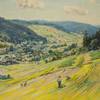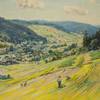

The beautiful landscape of the Texas Hill Country has been the subject of countless paintings and photos, drawing people to the area from all over the world.
It is here that artists come to be inspired.
While there have always been artists in the Hill Country, it seems that the industry has taken off in recent years, and galleries and exhibits abound.
Tucked away in the communities that make this area, artists are busy honing their craft. In every town, there is at least one gallery and art guild.
One such community has taken art to the streets!
All around downtown Lampasas, murals have been painted, led by Vision Lampasas, a group that was organized with the mission to enhance the Historic Downtown.
There are currently nine murals, all of which display a scene that portrays a piece of the Lampasas culture and history.
The first of such murals, named ‘Boot Roundup’, was painted in 2008. The Art Committee for Vision Lampasas initiated the first series, and for this first mural, a ‘Boot Call’ was done.
More than 100 pairs of boots were laid out on the ground and photographed from above. That image became the basis for the mural, which was chosen to represent the western heritage and in honor of local boot makers.
The mural took three months and over 1500 volunteer hours to complete. It was painted on the side of a building a block from the courthouse, that was owned by a Lampasas businessman and historian, Jerry Goodson.
Each of the murals were done using a paint-by-number format, allowing for volunteers to do as much or as little as they wanted.
The second mural completed is ‘Generations’, and it is located at Western and 2nd Streets.
It was done in tribute to the generations of businesses since the 1800s that have occupied the building on which it was painted. The Texas Trading Company, Lampasas Bowling Alley, Western Auto, Love Brothers Motor Company, and John Wade – current owner of Lampasas Hardware.
The third mural was inspired by vintage postcards, using big letters to spell out Lampasas and historic landmarks from around the community painted inside the letters.
Downtown, on the eastside of the square in the breezeway of the Lampasas County Annex, a mural was created as a tribute to Berta Dean Briggs Stanukinors, a Lampasas citizen who is remembered for her tireless work to preserve Sulphur Creek.
The mural is called ‘Water is Life’ and includes the main riverbed in a map of Lampasas, as well as three of five reservoirs. A waterline that shows how high flood waters rose in the Mother’s Day flood of 1957.
At the end of this walkway, the City of Lampasas has installed a small pocket park, with sculptures and a tables that are ready for chess or checkers.
At 4th and Pecan, a fifth mural was created. Giant hand painted seed packets show the wildflowers that can be found in the area. Hidden fauna can be found among the flora.
Hunting and fishing have long been big business in Lampasas and the surrounding county. Vision Lampasas constructed a mural with both paint and 3-D elements at 4th and Live Oak. It’s truly remarkable what they did!
Most of the buildings used were offered by business owners who requested that Vision Lampasas use their buildings as a canvas. Such is the case with the mural that has been painted over the canopy at the Trading Post Antiques and Collectibles.
The scene picked for that location depicts a photographer taking a photo of different scenes showing the life and times of Lampasas. It has been named ‘Portraits of the Past’.
The eighth mural is dubbed ‘Patriot’. A contest was held by Walmart for the design. Twenty-one people turned in a design, and the selection chosen was painted on a building at 405 N. Key Ave, on the Miller Services building. Local veterans, first responders and their families participated in the painting as well.
The latest mural to be added to the collection is located on Key Avenue as well.
‘Small Town...Big Sound’ is a 13-foot by 70-foot painting that highlights the music and musicians of Lampasas through the decades. The mural features special 3-D designs, including a music bench with a keyboard back that continues into the mural.
Local musicians Jason Roberts, Donnie Price, Dan Walton, Wesley Holtsford, and Louie Broussard recorded a special song, ‘Fool That I Am’, written by Donnie Price’s father. The song was played at the dedication ceremony and is available for purchase with all proceeds going to Vision Lampasas.
LAMPASAS – HANNA SPRINGS SCULPTURE GARDEN
Located in Campbell Park, the Hanna Springs Sculpture Garden was inspired by Lampasas artist Nancy Gray. The project was dedicated in July 2005. Steve Domigan, a winning landscape designer from Austin completed the garden’s Master Plan.
In September of 2005, three stone sculptures were carved on site. Those three pieces became the foundation for the garden. Under the direction of Gray, artists David Hickman, Carolann Haggard and TJ Mabrey crafted the inaugural sculptures.
Each year the Lampasas Association for the Arts (LAFTA) issues a call for sculpture, for varying pieces to be displayed in the garden for that year.
The park is open to all visitors, pets included. It is an immense park with quite a bit of distance between sculptures. Sightseers are able to get right up next to the sculpture. Lie in the lush grass and contemplate the statues or grab a quick nap under the tree canopy.
For more information, visit www.lafta.org.
GOLDTHWAITE- TEXAS BOTANICAL GARDENS & NATIVE AMERICAN INTERPRETIVE CENTER
Located just about 30 minutes north of Lampasas, Legacy Plaza is located in downtown Goldthwaite. The center includes the Texas Botanical Gardens as well as the Goldthwaite Welcome Center.
The Botanical Gardens were opened in October of 2014, and the Native American Interpretive Center will open in three years.
Legacy Plaza was founded by Jan Fischer, a retired science teacher, in 2004. The mission of the center is to offer visitors museum that is ‘green’ and presents an authentic living history experience, featuring the prehistoric period 20,000BC to 600AD.
Goldthwaite is located in Mills County. Records indicate that hunter-gatherers occupied that region for the longest continuous amount of time in North America.
There are still remnants visible today within archaeological sites located along the Colorado River.
The Texas Botanical Gardens offer a glimpse at the plant life used by native people who lived in this region over 10,000 years ago.
Visitors to the site will learn about methods of plant processing and baking used by those people who inhabited this area. An outdoor kitchen and Early Native American demonstration camp are also onsite, along with water exhibits and walking trails.
The center focuses on sustainability, and offers education on drought awareness, water conservation, and landscaping with native pants.
In the works now, is the Native American Interpretive Center. The center is planned to open in three years, and will focus on the lives of ancient Texans.
The project is being led by Robert Jackson and Michael McElhaney Architects, an architect firm known for their sustainable energy design. Working with the National Museum of the American Indian of the Smithsonian, the project is underway.
The goal of the exhibit will be to show the integrated lifestyle of Native Americans from the region, giving a hands-on look at how they lived.
There are plans educational workshops that will present a variety of topics relating to life in that period, including making baskets and tools.
For more information, visit www.legacyplaza.org.
LLANO MUSEUM
Just down the road a bit in Llano, the Llano County Historical Museum offers a look at the way life was in Llano during the early days.
Items on display exhibit the craftsmanship and attention to detail that was prevalent in those days.
The museum features a large polo exhibit that honors Cecil Smith, an internationally known Llanoite who held a 10-year handicap for 25 years, which has never been matched in the history of polo.
The museum itself is located is located in what was originally the Bruhl’s Drugstore building. Inside, the original marble soda fountain is still on display.
In addition to the regular museum, the Llano County Historical Society hosts an annual 70-plus day juried exhibit annually featuring western artists.
The show is held at the Llano County Museum, and showcases the craftsmanship of local, national, and internationally acclaimed artists. The display includes the finest in original western art, custom trappings and gear.
For more information about the museum, visit www.llanomuseum.org. for more information about Western Trappings www.westerntrappings.com.




